At the end of the fifteenth century, Christopher Columbus discovered the New World (1492), and a few years later (1498), Portuguese navigator Vasco da Gama opened the sea route between Europe and India by way of the Cape of Good Hope. It was the era of the great voyages, and from a European historic viewpoint, a period of “great discoveries”.
Portugal was the first European power to invade Asia. In 1510, they captured Goa of India, destroyed the kingdom of Malacca, and by having control of the Strait of Malacca, the Portuguese expanded their influences towards the southeast and northeast Asia. Moving north in an endeavour to trade with China and Japan, they occupied Macao in 1537.
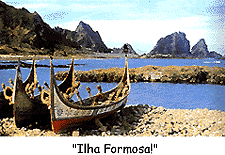 In 1517, a Portuguese fleet sailing through the Taiwan Strait on the way to Japan sighted Taiwan and called it Ilha Formosa, meaning “Beautiful Island.” This is the origin of Taiwan’s other name, Formosa. However, whenever they came across a beautiful island on the sea, Portuguese sailors had the habit of calling it “Ilha Formosa”, so there are more than ten islands in Africa, South America and Asia which bear the same name. Nevertheless, Formosa has become the proper name of Taiwan, and is now commonly used among Westerners.
In 1517, a Portuguese fleet sailing through the Taiwan Strait on the way to Japan sighted Taiwan and called it Ilha Formosa, meaning “Beautiful Island.” This is the origin of Taiwan’s other name, Formosa. However, whenever they came across a beautiful island on the sea, Portuguese sailors had the habit of calling it “Ilha Formosa”, so there are more than ten islands in Africa, South America and Asia which bear the same name. Nevertheless, Formosa has become the proper name of Taiwan, and is now commonly used among Westerners.
Pirates and Aborigines
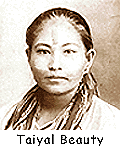 During the period when Western European powers were moving eastward, the Chinese and Japanese pirates knowned as Wo-k’ou , who had plundered the Chinese southeastern coast, used Taiwan as a base or hideout for geographical reason. When chased by the government forces, these pirates would flee first to Penghu (Pescadores) Islands, and then to Taiwan. Government forces might chase the pirates to Penghu, but would never persue them to Taiwan. In the sixteenth century, the Ming government (being unfamiliar with Taiwan) regarded Taowam as a dreadful, barbaric region spread with pestilences.
During the period when Western European powers were moving eastward, the Chinese and Japanese pirates knowned as Wo-k’ou , who had plundered the Chinese southeastern coast, used Taiwan as a base or hideout for geographical reason. When chased by the government forces, these pirates would flee first to Penghu (Pescadores) Islands, and then to Taiwan. Government forces might chase the pirates to Penghu, but would never persue them to Taiwan. In the sixteenth century, the Ming government (being unfamiliar with Taiwan) regarded Taowam as a dreadful, barbaric region spread with pestilences.
In the middle of the sixteenth century, there were only a small number of Han immigrants and Malayo-Polynesian aborigines who had dwelt on Taiwan for many thousands of years. Although presently these aborigines have become minority, they were once the major inhabitants spread over the entire island. All the aborigines are Malayo-Polynesian, however, they do not belong to same race. Beside the nine tribes of Atayal, Saisiyat, Tsou, Bunun, Rukai, Paiwan, Ami, Puyuma, Yami, there are Ketagalan, Luilang, Kavalan, Taokas, Pazeh Papora, Babuza, Hoanya, and Siraya, who are commonly called the “flatland aborigines“.
These aborigines have their different languages and customs, and constitute unique independent societies. From their different languages, customs and dwellings, one can imagine that they migrated from different places during different periods of time. The flatland aborigines were assimilated by Han settlers through inter-marriage, and are now almost indistinguishable from Han people. Because the aborigines were divided into so many racial groups, they have not been able to establish a united kingdom, and have been overwhelmed by foreign invaders and consequently hve become the minority.
The Origin of Taiwan
All the aborigines, with the exception of the “flatland aborigines”, were gradually squeezed and forced to move towards the mountains, and eventually became the “mountainers”. TheYami tribe that lived on the isolated island of Lanyu are the only aborigines still retaining the lifestyle of an oceanic race. While these “Mountainer” aborigines were called “Takasago” by Japanese during their occupation; the name was changed to “Gao-San-Zu” (mountain tribes) by the KMT regime of the Republic of China after the World War II.
Be it “Takasago” or “Gao-San-Zu”, these names were given by the Japanese and Chinese, and are definitely not what the aborigines call themselves. Fundamentally, it is in contempt of the aborigines seeing them as uncivilized savages. Moreover, all the foreign invaders who ruled Taiwan have under the pretense of “Savage Administrative Policy” segregated the aborigines from the Han immigrants by adopting the “divide and rule” scheme, deliverately creating the impression that the aborigines were “untamed savages”.
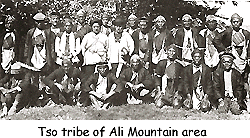 In fact, Malayo-Polynesians, who are widespread among Southeast Asian islands today, have become the primary races of the countries such as Philippines, Indonesia, Malaysia, Borneo, etc., and are very proud of their cultures and traditions. On the other hand, the aborigines in Taiwan have, since the era of the great voyages, been continuously oppressed and isolated from the modern civilization, and consequently have not been able to develop and refine their unique traditional cultures. Above all, they have been driven out of the flatlands to remote and mountainous regions.
In fact, Malayo-Polynesians, who are widespread among Southeast Asian islands today, have become the primary races of the countries such as Philippines, Indonesia, Malaysia, Borneo, etc., and are very proud of their cultures and traditions. On the other hand, the aborigines in Taiwan have, since the era of the great voyages, been continuously oppressed and isolated from the modern civilization, and consequently have not been able to develop and refine their unique traditional cultures. Above all, they have been driven out of the flatlands to remote and mountainous regions.
“Taioan” did not originate from Han language. The Siraya aborigines who dwelled in the vicinity of Tainan called outsiders and visitors “Taian” or “Tayan”, and it had been misheard as “Taioan”. Han immigrants and Japanese had applied different Han characters and Kanji, which became the name of the island itself. Between the years 1573 and 1620, Ming government began calling the island “Taiwan”, and the Dutch also used “Taioan” in their writings.
You can see from the origin of the name that, to the aborigines, the outsiders were just some visitors “passing by”. The aborigines never realized that the “passers-by” would become masters of the island, and treat them as “uncivilized savages”, the objects of “Savage Administrative Policy”. In this respect, there is a close resembrance to the fates of the Indians and Indeos in North American continent.
Unexpected Windfall for Dutch
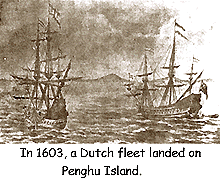 The Dutch, who fell one step behind the Portuguese and the Spanish in invasions, arrived at Jakarta, Indonesia (“Batavia” as called by the Dutch) in 1596. In 1602, the Dutch formed the first stock company in human history called the “Dutch East India Company”. With headquarters in Amsterdam, the Company was chartered for monopolized trade as well as managing newly acquired colonies. After establishing a foothold in Batavia, the Dutch planned immediately to trade with China and Japan, and began searching for a midway base. In 1603, the Dutch fleet sailed toward the Pescadores of Taiwan Straits, and landed on the main island Penghu. This was the first time that Western European power ever set foot on the land of Taiwan.
The Dutch, who fell one step behind the Portuguese and the Spanish in invasions, arrived at Jakarta, Indonesia (“Batavia” as called by the Dutch) in 1596. In 1602, the Dutch formed the first stock company in human history called the “Dutch East India Company”. With headquarters in Amsterdam, the Company was chartered for monopolized trade as well as managing newly acquired colonies. After establishing a foothold in Batavia, the Dutch planned immediately to trade with China and Japan, and began searching for a midway base. In 1603, the Dutch fleet sailed toward the Pescadores of Taiwan Straits, and landed on the main island Penghu. This was the first time that Western European power ever set foot on the land of Taiwan.
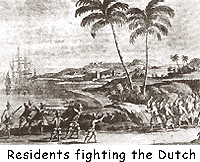 During theYuan Dynasty, the Mongol government had a garrison stationed at Penghu Island, but in 1388, the Ming government abolished the garrison station and abandoned the Pescadores. Having heard the arrival of Dutch fleet, the Ming government immediately sent troops to Penghu and expelled the Dutch from the island. After failing to occupy Penghu, the Dutch tried to wrest Macao from the Portuguese, but also failed. In July 1622, the Dutch made another attempt on Penghu Island and finally succeeded in occupying it.
During theYuan Dynasty, the Mongol government had a garrison stationed at Penghu Island, but in 1388, the Ming government abolished the garrison station and abandoned the Pescadores. Having heard the arrival of Dutch fleet, the Ming government immediately sent troops to Penghu and expelled the Dutch from the island. After failing to occupy Penghu, the Dutch tried to wrest Macao from the Portuguese, but also failed. In July 1622, the Dutch made another attempt on Penghu Island and finally succeeded in occupying it.
After landing on P’enghu Island, the Dutch mobilized the residents and fishermen in the harbor to build a fortress in Makung, and a trade base linking Batavia, Makung, China and Japan was established. The Dutch started to use this base to control traffic on the Taiwan Strait and to harass Portuguese vessels travelling to and from Japan. The Ming government, as a countermeasure, issued a decree in September 1623 banning all ships from approaching southeast coast of China.
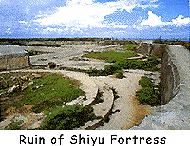 In January 1624, Ming forces attacked the Dutch on Penghu Island, and after warring for eight months, the Dutch signed a treaty with the Ming who gave the Dutch posts on Taiwan and other rights in exchange for withdrawing from Pescadores. It was a pleasant surprise to the Dutch, for even if they decided to defend Penghu they were no match against the towering Ming forces. Not only wasTaiwan a much bigger island than Penghu, it was also located in a strategic point of the trade route in East Asia, making it possible to monopolize trade with China and Japan. So, the Dutch immediately signed the peace treaty, and moved their fleet to Taiwan after destroying the fortress and military facilities on Penghu Island.
In January 1624, Ming forces attacked the Dutch on Penghu Island, and after warring for eight months, the Dutch signed a treaty with the Ming who gave the Dutch posts on Taiwan and other rights in exchange for withdrawing from Pescadores. It was a pleasant surprise to the Dutch, for even if they decided to defend Penghu they were no match against the towering Ming forces. Not only wasTaiwan a much bigger island than Penghu, it was also located in a strategic point of the trade route in East Asia, making it possible to monopolize trade with China and Japan. So, the Dutch immediately signed the peace treaty, and moved their fleet to Taiwan after destroying the fortress and military facilities on Penghu Island.
The Ming government agreed so easily to let the Dutch take over Taiwan, simply because China had never looked upon this island as its own territory.





